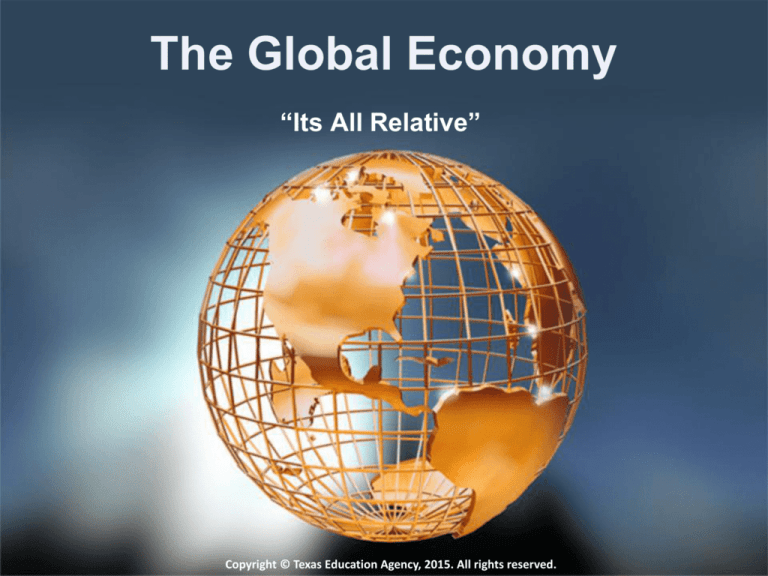
The Global Economy
“Its All Relative”
Copyright © Texas Education Agency, 2015. All rights reserved.
OBJECTIVES:
• Understand the impact of global trade on the U.S.
economy
• Explain the role of balance of trade in relation to
imports and exports
• Compare & contrast emerging economies with
existing economies
• Evaluate the growth of multinational companies
• Discuss preindustrial and postindustrial economic
systems
• Explain the importance of finding the right mix for
foreign markets
Copyright © Texas Education Agency, 2015. All rights reserved.
TERMINOLOGY:
•
•
•
•
•
•
•
•
NAFTA: North American Free Trade Agreement
WTO: World Trade Organization
EU: European Union
International Trade: The sale of products/services to people in
other countries
Imports: Products/services purchased from another country
Exports: Products/services sold to another country
Indirect Exporting: Marketers with exporting experience
represent the exporting company; arranges for the sale of
products in other countries
Direct Exporting: Company handles all responsibilities to
market products in other countries
Copyright © Texas Education Agency, 2015. All rights reserved.
• Balance of Trade: The difference between a country’s imports
and exports
• Foreign Production: A company owns and operates production
facilities in another country
• Joint Venture: Two or more companies in different countries
with common interests develop a relationship to join in
common business activities
• Multinational Companies: Businesses that have operations all
over the world and conduct planning for worldwide markets.
• Preindustrial economy: Based on agriculture & raw material
development; low standard of living.
• Postindustrial economy: Based on mix of business and
consumer products/services produced & marketed in the
global marketplace
• Gross Domestic Product: The total $ value of all good/services
produced within a country in one year
• Gross National Product: The total $ value of all goods/services
produced
Copyright © Texas Education Agency, 2015. All rights reserved.
• Quota: Limits on the numbers of certain types of products
foreign companies can sell in a country
• Tariffs: Taxes placed on imported products to increase the
selling price
• Subsidy: Money provided to a business to help in the
development and sale of products
• Standard of Living: A measure of the quality of life for the
citizens of a country
• Productivity: The average output by workers for a specified
period of time
• Purchasing Power: The amount of goods/services that can be
bought with a specific $ amount of money
• Consumer Price Index: The variance in the cost of a specified
set of goods over time
• Business Cycle: Consists of four stages: Prosperity, Recession,
Depression and Inflation
Copyright © Texas Education Agency, 2015. All rights reserved.
I. U.S. and International Trade
• World Interdependence
– Approximately 1/3 of worldwide production is
sold outside of the “home” country
– The bulk of products Americans use daily are
imported
– U.S. exports music, movies, cars, airplanes, and
food items
• International Trade is Changing
– Raw materials once were an abundant
commodity; today it makes up less than 1/3 of
the world’s exports
– Manufactured goods/services are most popular
Copyright © Texas Education Agency, 2015. All rights reserved.
• Services (communications, travel, education & financial)
are most popular exchanges between countries
• Data is transferred via phone, fiber optics, or satellite on
daily basis
II. Businesses are Going Global
• Markets are changing
– Foreign markets are enticing to domestic businesses
who experience dropping sales & profit
– Another way to expand competition
– Increasing worldwide demand for products
• Benefits of international marketing
– Government support is available
Copyright © Texas Education Agency, 2015. All rights reserved.
Importance of International Trade
•
•
•
•
•
•
•
•
•
•
U.S. economy: Over 250,000 businesses export products
Accounts for over 11% of GNP
95% of U.S. exporting businesses are small to medium sized
Manufacturers export over $500 billion of products
Wholesalers export over $100 billion
U.S. is second largest exporter
Germany is #1 exporter of products
U.S. is #1 importer of products
Germany is #2 importer of products
U.S. had 1st trade deficit of 20th Century in 1971 (imports
exceeded exports by over $1 billion that year)
Copyright © Texas Education Agency, 2015. All rights reserved.
III. 2000: Top 25 Companies
•
•
•
•
•
•
•
•
•
•
•
•
•
ICBC (China; banking) 1
China Construction Bank (banking) 2
JP Morgan Chase (banking) 3
General Electric ( U.S. conglomerate, owns NBC and Comcast) 4
Exxon Mobile (oil & gas) 5
HSBC Holdings (UK banking) 6
Royal Dutch Shell Oil (Netherlands, oil & gas) 7
Agricultural Bank of China ( China, banking) 8
PetroChina (China, oil) 9
Berkshire Hathaway (U.S. Diversified Financial) 10
Bank of China (banking) 11
Wells Fargo (U.S. banking) 12
Chevron (U.S. oil & gas) 13
Copyright © Texas Education Agency, 2015. All rights reserved.
Continued
•
•
•
•
•
•
•
Volkswagen Group (Germany world’s largest auto maker) 14
Apple (U.S. Tech Hardware & Equipment) 15
WalMart (U.S. retailing) 16
Gazprom (Russia oil & gas—largest producer in the world) 17
BP (U.K. Oil & Gas) 18
Citigroup (U.S. Banking) 19
Petrobras (Brazil Oil & Gas) 20
Source: http://www.forbes.com/global2000/
Copyright © Texas Education Agency, 2015. All rights reserved.
Interpreted…
• Global 2000 companies study:
– Include 63 countries
– $38 trillion in revenues
– $159 trillion in assets
– Employ 87 million worldwide
– Country Ranking:
• U.S. (543 members)
• Japan (251 members)
• China (136 members)
Copyright © Texas Education Agency, 2015. All rights reserved.









